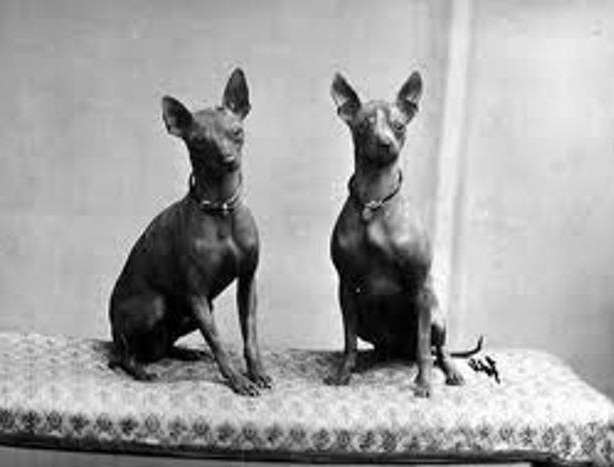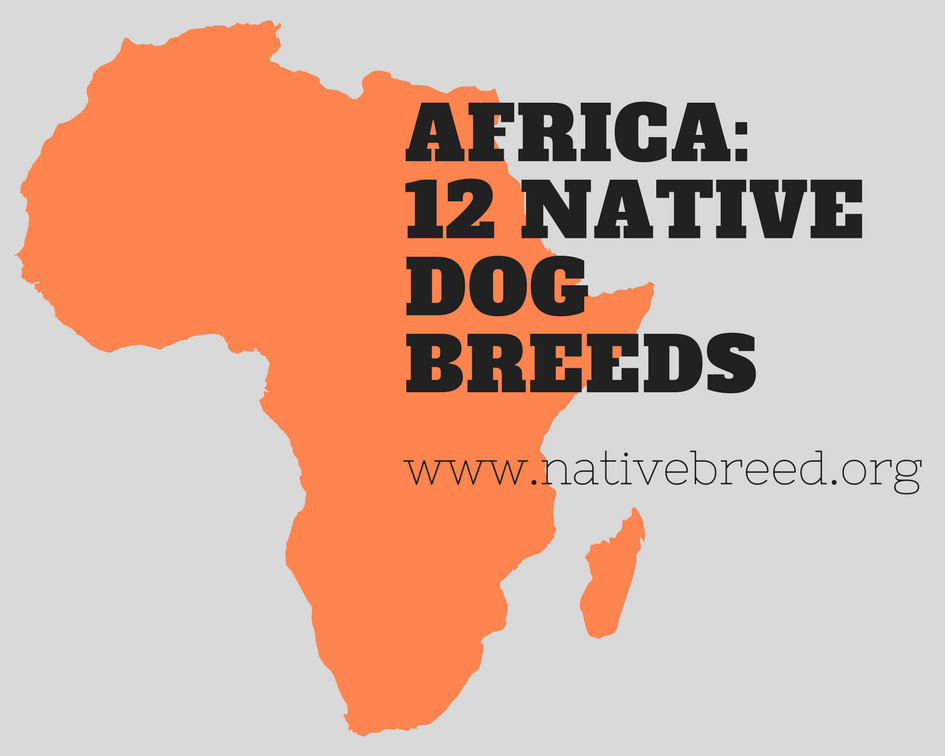1.Abyssinian Sand Terrier

The Abyssinian Sand Terrier or African Hairless Dog is a breed of hairless dog. It can grow 15.5 to 20.5 in (39 to 52 cm) height and weigh 21 to 39 lb (9.5 to 17.7 kg). Abyssinian Sand Terriers are hairless except for the skull and towards the end of the tail. However, some dogs are totally hairless. They come in bronze, elephant-grey, greyish-black, black, pale sandy and mottled. Their ears are rose-shaped.
The Abyssinian Sand Terrier’s head is broad in the skull with a long, tapered muzzle. The eyes are medium and almond-shaped but do not bulge. Their ears are either rose-shaped or large and bat-like; both are very thin in texture. The nose is usually black, but many Abyssinian Sand Terriers have a nose that is the same colour as their coat. Their bite is scissor or level. The neck is arched slightly and gets thicker the closer it gets to the shoulders. The Abyssinian Sand Terrier has a very deep and broad chest, with the depth reaching the elbows. This breed has a level back and a round rump. The tail is low set and tapers to a fine point. This dog has a good reach in its gait and is very well balanced. Abyssinian Sand Terriers are fearless, loyal and willing to please.
2.Africanis
The Africanis is a landrace of Southern African dogs. It is believed to be of ancient origin, directly descended from hounds and pariah dogs of ancient Africa, introduced into the Nile Valley from the Levant. Africanis is also an umbrella name for all the aboriginal dogs in Southern Africa.
While the Africanis Society of Southern Africa has conceptualised the Eurocentric term of “Africanis” to encapsulate all African breeds of dog, there do exist numerous specialised types developed by various African ethnic groups with their own indigenous and ancient names. These types are not “landraces” as dictated by the Africanis Society, but rather unusual types developed for certain specific conditions and that do exhibit differences in one type from the other.
The Africanis Society of Southern Africa aims to conserve the Africanis as a landrace rather than develop it as a breed. While the Africanis is recognized by the Kennel Union of South Africa (KUSA) as an emerging breed, researchers on the ground, such as anthropologist Sian Hall, hold that the various different types of indigenous African dogs have already developed, over thousands of years, as types suited to their specific conditions by Africa’s own indigenous peoples. They, therefore, have no need to be Eurocentrically regarded as an “emerging breed” by European canine institutions. Hall holds that the dogs have already developed as distinct types among the various African groups and that each deserves to be regarded and recognised as such. It follows that one breed description cannot be allocated to the many different types of indigenous dogs on the African continent.
3.Aidi
The Aidi refer to the word “dog” in Tamazight aydi, is a Berber dog breed used as a livestock guardian, protecting herds of sheep and goats. It also possesses hunting capabilities and good scenting ability. In its native North Africa, it is often paired in hunting with the Sloughi, which chases down prey that the Aidi has located by scent.
4.Armant dog
Armants originate from Egypt and were originally used as guard dogs. It is believed to be a descendant of European dogs, that was introduced by Napoleon’s troops, crossed with Briards. They are named after the town of Armant in Egypt. The breed’s fearlessness when confronted by predators as well as its loyalty see them put to use in Egypt as guard dogs.
5.Azawakh
Also Read about: Azawakh Dog Breed.
The Azawakh is a breed of dog from West Africa. It is also used as a sighthound, they have been relegated to a secondary function of a camp guardian due to the lack of game in the region. With ancient origins, it is raised throughout the Sahelian zone of Mali, Niger, and Burkina Faso. This region includes the Azawagh Valley for which the breed is named. While commonly associated with the nomadic Tuareg people, they are also bred and owned by other ethnic groups such as the Peulh, Bella, and Hausa. The Azawakah is more related to the Sloughi than it is to the Saluki.
6.Basenji
The name comes from the Lingala language of the Congo, mbwá na basɛ́nzi which means ‘villager dogs’.
The Basenji is a breed of hunting dog. It was bred from stock that originated in central Africa. Most of the major kennel clubs in the English-speaking world place the breed in the hound group more specifically, in the sighthound type. The Fédération Cynologique Internationale places the breed in its group five (spitz and primitive types), and the United Kennel Club (US) places the breed in its Sighthound and pariah group.
The Basenji produces an unusual yodel-like sound (commonly called a “baroo”), due to its unusually shaped larynx. This trait also gives the Basenji the nickname “barkless dog”.
Basenjis share many unique traits with pariah dog types. Basenjis, like dingoes, New Guinea singing dogs and some other breeds of dog, come into estrus only once annually—as compared to other dog breeds, which may have two or more breeding seasons every year. Both dingoes and Basenji lack a distinctive odor, and are prone to howls, yodels, and other vocalizations over the characteristic bark of modern dog breeds. One theory holds that the latter trait is the result of selecting against dogs that frequently bark—in the traditional Central African context—because barking could lead enemies to humans’ forest encampments. While dogs that resemble the Basenji in some respects are commonplace over much of Africa, the breed’s original foundation stock came from the old-growth forest regions of the Congo Basin, where its structure and type were fixed by adaptation to its habitat, as well as use (primarily net hunting in extremely dense old-growth forest vegetation). Read more…
7.Boerboel
The Boerboel, also known as the South African Mastiff, is a large, Molosser-type breed from South Africa and are bred for the purpose of guarding the homestead. These dogs were bred as working farm dogs and are one of the most powerful dog breeds in the world and have a bite force of up to 800 psi.
The Boerboel is a large dog, with a strong bone structure and well-developed muscles. The head appears blocky, but not overdone, with a short length between the stop and nose. It should look impressive, carrying himself with confidence and powerful movement, which should be buoyant, and unencumbered, despite its size. It should be symmetrical and balanced, following the desired proportions for the breed. Males should be markedly bigger than females, there is a distinct sexual dimorphism, with the female less prominently developed physically. Read More…
8.Chinese Crested Dog
Read More about: Chinese Crested Dogs
9.Coton de Tulear
The Coton de Tuléar is a breed of small dog named for the city of Tuléar (also known as Toliara) in Madagascar. This breed is thought to have originated from a group of small white dogs who swam across the Malagasy channel following a shipwreck. Known for its cotton-like coat, the Coton de Tuléar, typically grows to no more than 18 pounds, and are white, sometimes with grey, black, or tricoloured markings.
Multiple registries with differing standards describe the Coton de Tulear, but it generally has very soft hair (as opposed to fur), comparable to a cotton ball (hence its name in French, coton meaning cotton), a prominent black nose, large expressive eyes (usually covered by bangs), and somewhat short legs. The Coton de Tulear’s tail should curl over its back. Read More…
10.Rhodesian Ridgeback
The Rhodesian Ridgeback is a dog breed bred in the Southern Africa region. Its forebears can be traced to the semi-domesticated, ridged hunting dogs of the Khoikhoi, which were crossed with European dogs by the early colonists of the Cape Colony of southern Africa. The original breed standard was drafted by F. R. Barnes, in Bulawayo, Southern Rhodesia (now Zimbabwe), in 1922, who named the breed the Rhodesian Ridgeback. The standard was approved by the South African Kennel Union in 1927.
The Rhodesian Ridgeback has also previously been known as Van Rooyen’s lion dog or the African Lion Hound or African Lion Dog—simba inja in Ndebele, shumba imbwa in Shona—because of its ability to keep a lion at bay while awaiting its master’s arrival. Read More…
11.Sloughi
The Sloughi is a North African breed of dog, specifically a member of the sighthound family. It is found mainly in Morocco, which is responsible for the standard, and may be found in smaller numbers elsewhere in North Africa.
The Sloughi has existed for centuries in North Africa and is largely found in Morocco. Morocco is responsible for the breed’s FCI Standard. The Sloughi was and still is used for hunting in its native countries, and also is a reliable guard dog. Today, the Sloughi is mainly found in Morocco, Algeria, Tunisia, and Libya. Read More…
12.Tesem
Tesem was the Ancient Egyptian name for “hunting dog”. In popular literature, it denotes the prick-eared, leggy dog with a curled tail from the early Egyptian age, but it was also used with reference to the lop-eared “Saluki/Sloughi” type; it was one of several types of dogs in Ancient Egypt, particularly the latter type had an appearance most similar to that of a greyhound.


Leave a Comment